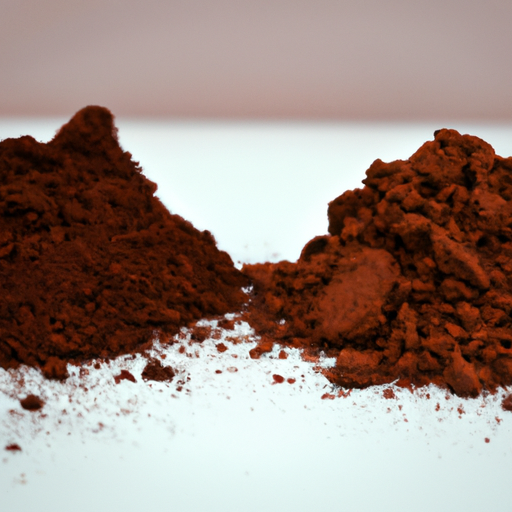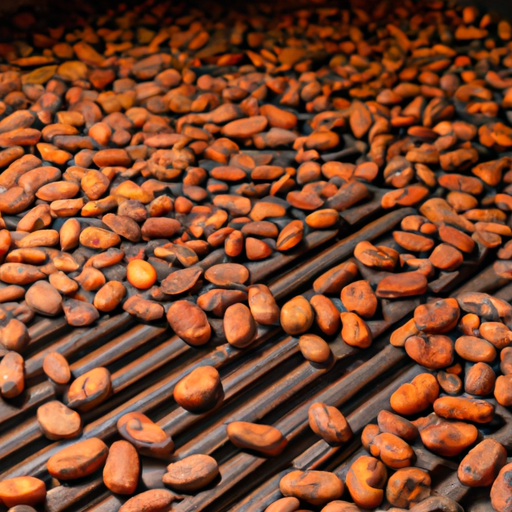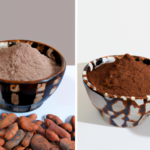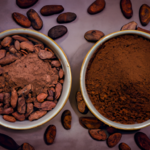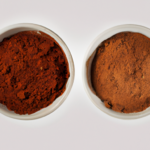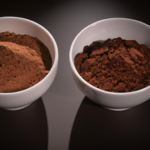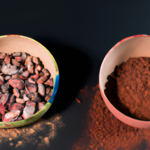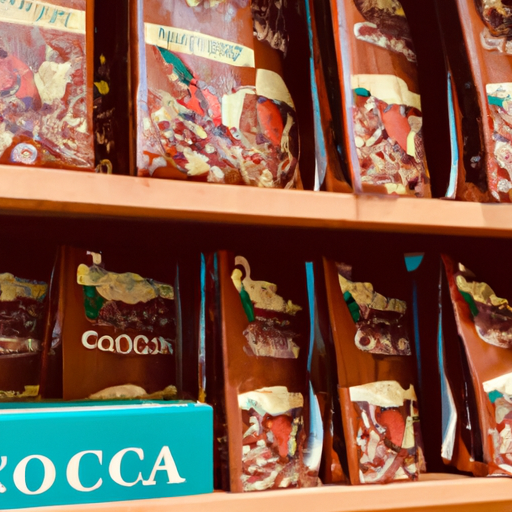You might be wondering, ‘Aren’t cocoa and cacao the same?’ Let me clarify that although they may seem alike, there are distinct differences between the two.
In this article, we will explore the origins, processing methods, nutritional differences, flavor profiles, culinary uses, health benefits, availability, and price differences between raw cocoa and cacao.
By the end of this article, you will have a clear understanding of what sets these two apart and how they can be used in various culinary applications.
So, whether you’re a chocolate lover or a health-conscious individual, join me as we delve into the wonderful world of cocoa and cacao and discover the nuances that make each unique.
Key Takeaways
- Raw cocoa and cacao have different flavors.
- Raw cocoa is more accessible and less expensive than cacao.
- Both raw cocoa and cacao offer numerous health benefits.
- Raw cocoa retains more natural nutrients due to minimal processing.
Origins of Cocoa and Cacao
Cocoa and cacao, two beloved ingredients, have fascinating origins.
Historical significance surrounds both cocoa and cacao, as they have been used for centuries by ancient civilizations. Cacao, originating from the tropical regions of the Americas, was highly valued by the Mayans and Aztecs. They believed it had divine properties and used it in rituals and as currency.
Cocoa, on the other hand, evolved from cacao through processing methods developed by the Europeans during the colonial era.
The cultural impact of cocoa and cacao cannot be overstated, as they became integral to various cuisines and beverages worldwide. From traditional Mexican hot chocolate to European chocolate bars, these ingredients have left an indelible mark on our culinary landscape.
Moving on to processing methods, let’s explore how cocoa and cacao are transformed into the delectable treats we enjoy today.
Processing Methods
When it comes to processing raw cocoa, the first step is to harvest the cocoa pods and extract the beans.
These beans are then fermented and dried to remove excess moisture.
After drying, the beans are roasted to develop their flavor and remove any remaining moisture.
On the other hand, cacao processing involves a similar process, but with a few differences.
The beans are also fermented and dried, but they are not typically roasted, which results in a more pure and less processed product.
How raw cocoa is processed
After it’s harvested, the cacao bean undergoes a series of steps to become raw cocoa, resulting in a rich and flavorful ingredient that can be used in a variety of delicious treats.
To process raw cocoa, the cacao bean is first fermented to enhance its flavor and reduce bitterness. Then, it is sun-dried to remove excess moisture and further develop its aroma.
Next, the dried beans are roasted at a low temperature to bring out the chocolatey flavors. Finally, the roasted beans are ground into a fine powder, which is the raw cocoa.
This processing method helps retain the natural antioxidants and minerals present in the cacao bean, making raw cocoa a healthier choice compared to processed cocoa.
Moving on to how cacao is processed, the following steps transform the raw cocoa into various cocoa products.
How cacao is processed
To transform the raw cacao into various cocoa products, the fermented and sun-dried beans are carefully crushed and ground into a velvety smooth paste. The first step in processing cacao involves separating the beans from their pods and fermenting them in wooden boxes for several days. This fermentation process enhances the flavor and reduces bitterness.
After fermentation, the beans are spread out to dry in the sun, which takes about a week. Once dried, the beans are roasted to bring out the rich chocolate flavor. The roasted beans are then cracked and winnowed to remove the outer shell, leaving behind the nibs.
These nibs are ground into a fine paste called chocolate liquor, which can be further processed into cocoa powder or cocoa butter.
Cacao farming techniques aim to maximize yield while minimizing the environmental impact, focusing on sustainable practices and preserving biodiversity.
Transitioning into the subsequent section, it is important to explore the nutritional differences between raw cocoa and cacao.
Nutritional Differences
Cacao and raw cocoa have distinct nutritional profiles, offering unique health benefits. When comparing the two, it’s important to consider their nutritional differences and the implications for our health.
In terms of nutritional comparisons, cacao contains higher amounts of essential minerals such as magnesium, iron, and potassium compared to raw cocoa. These minerals play a crucial role in various bodily functions, including muscle function, nerve transmission, and immune system health. Additionally, cacao is a rich source of antioxidants, which help combat oxidative stress and reduce the risk of chronic diseases.
To better understand the nutritional disparities, let’s take a closer look at the table below:
| Nutrient | Cacao | Raw Cocoa |
|---|---|---|
| Magnesium | 429 mg | 272 mg |
| Iron | 13.9 mg | 11.9 mg |
| Potassium | 1524 mg | 1311 mg |
| Antioxidants | High | Moderate |
These variations in nutrient content can have significant health implications. For example, the higher magnesium content in cacao may promote healthy blood pressure levels and support cardiovascular health. The abundant antioxidants in cacao also contribute to its potential anti-inflammatory and anti-cancer properties.
In the subsequent section about flavor profiles, we will explore how these nutritional differences translate into distinct tastes and aromas.
Flavor Profiles
With its rich and velvety taste, cacao tantalizes the taste buds, transporting us to a world of indulgence and decadence.
When it comes to flavor profiles, cacao and raw cocoa have distinct differences. Cacao has a deep, complex flavor with fruity and floral notes. It is often described as bitter but in a pleasant way, similar to dark chocolate.
On the other hand, raw cocoa has a milder taste with a slight nutty undertone. It is less bitter and has a smoother finish compared to cacao. These flavor preferences make cacao a popular choice for those who enjoy bold and intense flavors, while raw cocoa appeals to those who prefer a subtler taste.
Moving on to culinary uses, both cacao and raw cocoa can be incorporated into various recipes to enhance the flavor and create delectable treats.
Culinary Uses
In cooking and baking, raw cocoa is often used as a key ingredient to add depth and richness to various recipes. Its intense flavor and natural bitterness make it a popular choice for making decadent desserts like brownies, cakes, and truffles.
Additionally, raw cocoa can be used to make hot chocolate or as a dusting for desserts, providing a distinct and indulgent taste.
On the other hand, cacao, which is the processed form of raw cocoa, has a wider range of culinary applications. It can be used to make chocolate bars, sauces, and even savory dishes like mole. Its versatility and unique flavor profile make it a beloved ingredient in the culinary world.
How raw cocoa is used in cooking and baking
When it comes to cooking and baking, raw cocoa can be used in various ways to enhance the flavor of desserts. One popular technique is incorporating raw cocoa powder into the dry ingredients of a recipe, such as cakes, cookies, or brownies. This ensures that the cocoa is evenly distributed throughout the batter, resulting in a delicious chocolatey taste.
Another method involves melting raw cocoa butter to create a chocolate sauce or ganache. By combining the melted cocoa butter with sweeteners or dairy, a delectable sauce or frosting can be made. This can be drizzled over desserts or used as a frosting to add a rich and indulgent touch.
In addition to these techniques, raw cocoa can also be used to make hot chocolate or mixed into smoothies for a healthy and satisfying treat. Its versatility allows for a wide range of culinary applications, making it a staple ingredient in many dessert recipes.
Culinary applications of cacao
When using cacao in culinary creations, its deep, bitter flavor can elevate savory dishes like chili con carne, adding a unique richness and complexity to the dish. For example, a renowned chef experimented by adding a small amount of cacao powder to their traditional chili recipe, resulting in a deep, smoky undertone that perfectly complemented the spiciness of the dish.
Cacao powder can also be used to create delectable chocolate desserts. Its intense flavor and fine texture make it an ideal ingredient for creating rich, decadent treats like chocolate mousse, brownies, or truffles.
Additionally, cacao powder can be incorporated into smoothies or hot beverages, providing a natural, chocolatey taste without the added sugars and artificial flavors of traditional cocoa mixes.
These culinary applications of cacao demonstrate its versatility and ability to enhance a wide range of dishes and desserts.
In the next section, we will explore the health benefits of cacao and how it can contribute to a nutritious diet.
Health Benefits
Enjoy the numerous health benefits of raw cocoa and cacao, allowing yourself to indulge guilt-free in their antioxidant-rich properties.
Both raw cocoa and cacao are packed with beneficial compounds that can positively impact our well-being. They are known to improve heart health by reducing blood pressure and increasing blood flow.
Additionally, these superfoods contain flavonoids, which have anti-inflammatory effects and can boost our immune system. Raw cocoa and cacao also have mood-enhancing qualities, thanks to their content of serotonin and dopamine, the neurotransmitters responsible for happiness and pleasure.
Moreover, they are a great source of fiber, iron, and magnesium, which are essential for maintaining a healthy body. So, by incorporating raw cocoa and cacao into your diet, you can enjoy a range of health benefits.
Now, let’s explore their availability and accessibility.
Availability and Accessibility
Despite their reputation as luxurious and indulgent treats, finding raw cocoa and cacao products is as easy as pie, making it convenient for anyone to add these health-boosting superfoods to their daily routine.
However, there are some availability challenges to consider. While raw cocoa and cacao products are widely available in many regions, there may be limited options in more remote areas or countries with less developed infrastructure. Accessibility can also vary depending on the form of the product, with raw cocoa powder being more readily accessible than whole cacao beans or cacao nibs.
Despite these challenges, the increasing popularity of raw cocoa and cacao has led to a wider distribution and availability, making it easier for consumers to find these superfoods.
Moving on to price differences, it’s important to analyze the cost aspect when considering incorporating these products into one’s diet.
Price Differences
One thing to note is that the cost of incorporating these health-boosting superfoods into your diet can vary significantly. When it comes to price differences between raw cocoa and cacao, there are a few factors to consider. The production methods and quality variations play a significant role in determining the price of these products. Raw cocoa tends to be less expensive compared to cacao because it undergoes less processing. However, this also means that raw cocoa may have a slightly bitter taste and a lower fat content. On the other hand, cacao is usually more expensive due to its higher quality and richer flavor. It undergoes additional processing, which includes roasting and grinding, resulting in a smoother and more intense chocolate flavor. Therefore, the choice between raw cocoa and cacao ultimately depends on personal preference and budget. In summary, understanding the price differences between raw cocoa and cacao can help you make an informed decision about which superfood to incorporate into your diet. Transitioning into the next section, it is important to consider the overall benefits and drawbacks of these health-boosting superfoods.
Summary and Conclusion
In the realm of health-boosting superfoods, the choice between raw cocoa and cacao is like deciding between a gentle breeze or a powerful gust, each offering their own unique benefits and flavors.
To summarize the comparison of these two rich sources of antioxidants and minerals, here are the key points:
- Raw cocoa is made from cocoa beans that have been roasted at a high temperature, while cacao is made from raw, unroasted cocoa beans.
- Raw cocoa retains more of its natural nutrients, including antioxidants, magnesium, and iron, due to minimal processing.
- Cacao has a stronger, more bitter taste compared to the milder flavor of raw cocoa.
- Both raw cocoa and cacao have been linked to various health benefits, such as improving cardiovascular health, boosting mood, and enhancing cognitive function.
In conclusion, whether you choose raw cocoa or cacao, you can enjoy the numerous health benefits they offer, while savoring their distinct flavors and indulging in a guilt-free treat.
Frequently Asked Questions
How does the processing method affect the nutritional content of cocoa and cacao?
The processing method significantly impacts the nutritional content of cocoa and cacao. Factors such as heat, fermentation, and roasting can affect the levels of antioxidants, minerals, and vitamins in the final product.
Can raw cocoa and cacao be used interchangeably in recipes?
Raw cocoa and cacao can be used interchangeably in recipes due to their similar taste and texture. However, it’s important to note that there may be slight nutritional differences between the two, depending on the processing methods used.
Are there any potential health risks associated with consuming raw cocoa or cacao?
There are no potential health risks associated with consuming raw cocoa or cacao. In fact, both have potential health benefits when consumed in moderation. The recommended daily intake varies depending on the individual’s age, weight, and overall health.
Is there a significant price difference between raw cocoa and cacao?
There is a significant price difference between raw cocoa and cacao. Raw cocoa is generally more expensive due to its higher nutritional content, which includes antioxidants, minerals, and vitamins.
Are there any specific regions known for producing high-quality cocoa or cacao?
There are specific regions renowned for producing high-quality cocoa or cacao. These regions include West Africa, particularly Ivory Coast and Ghana, as well as Latin American countries like Ecuador, Venezuela, and Peru.
Are Raw Cocoa and Cacao the Same Thing?
Yes, there is a difference between raw cacao vs cocoa powder. Raw cacao is made by cold-pressing unroasted cocoa beans. It retains more nutrients and has a stronger, more bitter taste. Cocoa powder, on the other hand, is made by roasting the beans at high temperatures, resulting in a milder flavor and lower nutritional content.
Conclusion
In conclusion, the difference between raw cocoa and cacao can be seen in various aspects:
-
Origins: Cocoa and cacao come from the same plant, but cocoa is often associated with beans that have been grown in West Africa, while cacao is typically associated with beans from Central and South America.
-
Processing methods: Cocoa beans are usually roasted at higher temperatures, while cacao beans are minimally processed and often dried naturally.
-
Nutritional profiles: Due to the minimal processing, cacao retains more nutrients, such as antioxidants and minerals, compared to cocoa.
-
Flavor profiles: Cocoa has a smoother and sweeter taste, making it ideal for desserts and hot chocolate. On the other hand, cacao is more bitter and earthy, which lends itself well to savory dishes and dark chocolate.
-
Culinary uses: Both cocoa and cacao have unique culinary uses. Cocoa is commonly used in baking, confections, and beverages, while cacao can be used in similar ways but also to add depth of flavor to savory dishes like chili or mole sauce.
-
Health benefits: Cacao is often touted for its potential health benefits due to its higher nutrient content, including potential mood-boosting effects and cardiovascular benefits. However, cocoa also contains beneficial compounds, although in slightly lower amounts.
-
Availability and accessibility: Cocoa is more widely available and accessible in most grocery stores, while cacao may be found in specialty stores or health food markets.
-
Price: Due to the differences in processing and availability, cacao is generally more expensive than cocoa.
So, next time you’re at the grocery store, ask yourself, which one will you choose for your next chocolatey creation?

